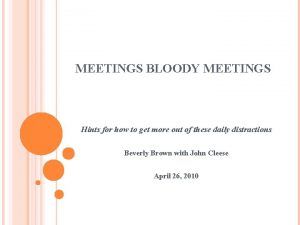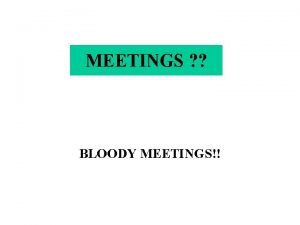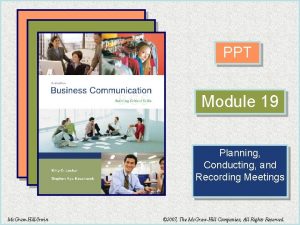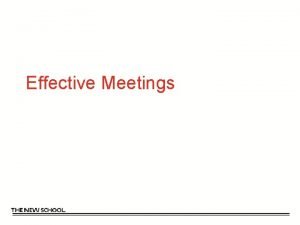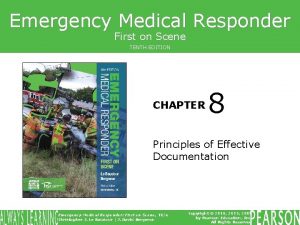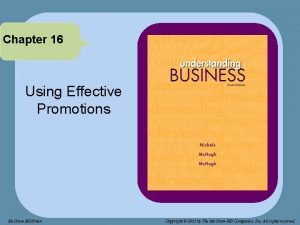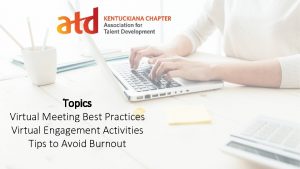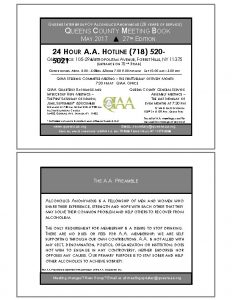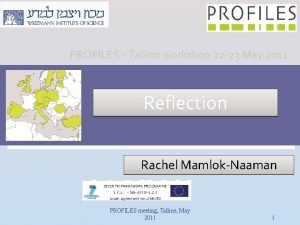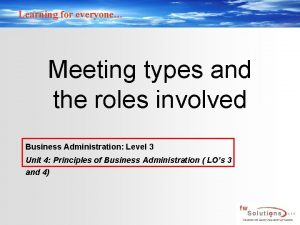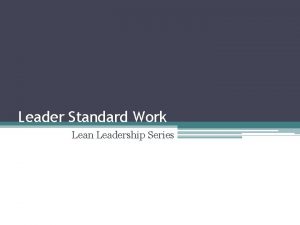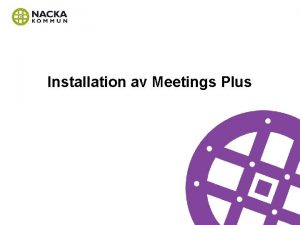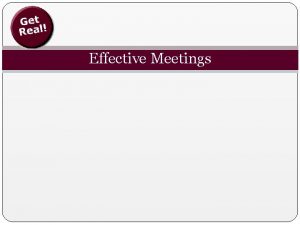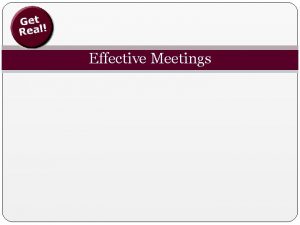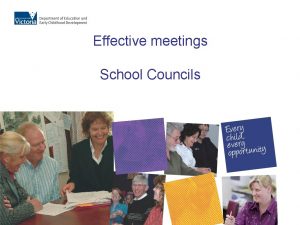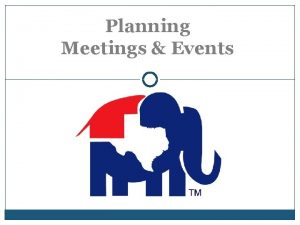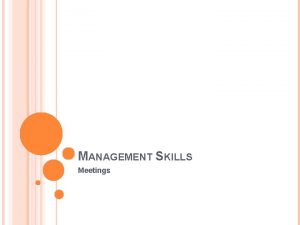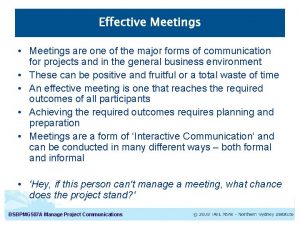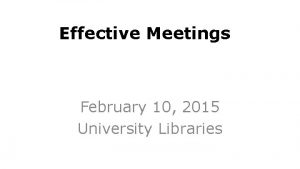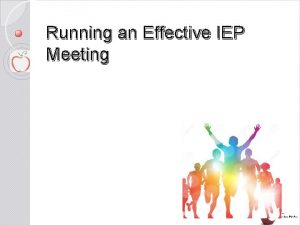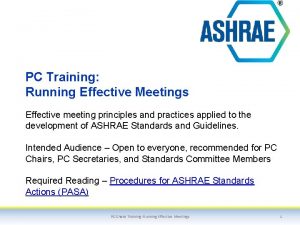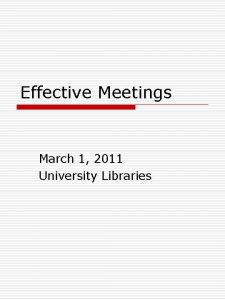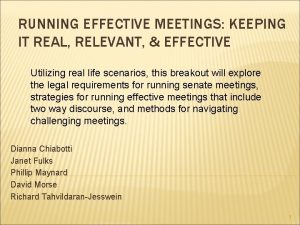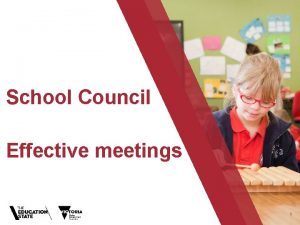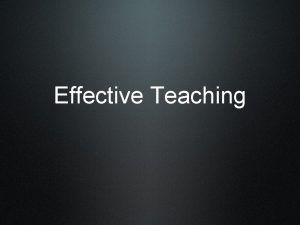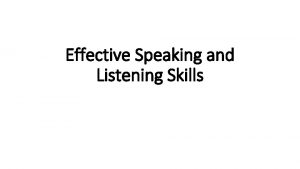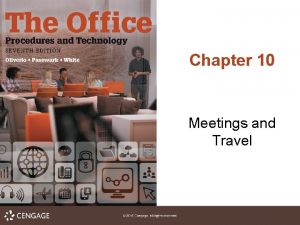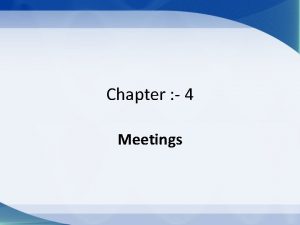Chapter 9 Effective Meetings Meetings Are common Are





















- Slides: 21

Chapter 9: Effective Meetings

Meetings • Are common • Are costly • Are not always productive • Contribute to organization’s culture

Types of Meetings • Information-sharing • Problem-solving or Decision-making • Ritual activities

Types of Meetings • Virtual Meetings – Teleconferences – Videoconferences

Planning Problem-Solving Meeting When to Hold Meeting • Task is beyond one person’s capacity – Information – Time • Interdependent tasks

Planning Problem-Solving Meeting When to Hold Meeting • More than one decision or solution • Likely to have misunderstandings or reservations

Planning Problem-Solving Meeting Setting Agenda • Topics covered in meeting • Questions to ask: – Tasks in meeting – Important conversations – Information to begin

Planning Problem-Solving Meeting Setting Agenda • Agenda items – Time, length, location – Participants – Background information

Planning Problem-Solving Meeting Setting Agenda • Agenda items – Items and goals • Result-oriented • Specific • Realistic – Pre-meeting work

Planning Problem-Solving Meeting Setting Agenda • Order of agenda items

Conducting Meeting Beginning • • • Identify goals Provide background Show group can help Preview meeting Identify time constraints

Conducting Meeting Conducting Business • Parliamentary procedure – Use when: • External audience interested in decisions • Haste may obscure thinking • Strong emotions

Conducting Meeting Conducting Business • Parliamentary procedure – Order of business • • Reading minutes Reports Unfinished business New business – Motions

Conducting Meeting Conducting Business • Participation – Use Nominal Group Technique – Have members take turns

Conducting Meeting Conducting Business • Participation – Use questions • Overhead • Direct • Reverse • Relay

Conducting Meeting Conducting Business • Keeping discussions on track – Remind group of time pressure – Summarize and redirect discussion – Use relevancy challenges – Promise to address good ideas later

Conducting Meeting Conducting Business • Keeping positive tone – Ask questions – Paraphrase • Check understanding • Allow for elaboration

Conducting Meeting Conducting Business • Keeping positive tone – Enhance value of comments • Acknowledge idea’s merits • Explain your concerns • Build on idea or ask for suggestions – Pay attention to cultural factors

Conducting Meeting Concluding • When to close meeting: – At scheduled closing time – Group lacks resources to continue – Agenda has been covered

Conducting Meeting Concluding • How to conclude – Signal ending time – Summarize accomplishments and future actions – Thank group

Following Up Meeting • Build agenda for next meeting • Follow up on other members • Complete your assignments
 Insidan region jh
Insidan region jh John cleese meetings bloody meetings
John cleese meetings bloody meetings Meetings bloody meetings
Meetings bloody meetings Meetings bloody meetings 5 points
Meetings bloody meetings 5 points Conducting effective meetings ppt
Conducting effective meetings ppt 4 p's of effective meetings
4 p's of effective meetings Meeting rules
Meeting rules What is the greatest common factor of 48 and 60?
What is the greatest common factor of 48 and 60? Common anode and common cathode
Common anode and common cathode Factor tree of 48
Factor tree of 48 What are the factors for 54
What are the factors for 54 Factors of 18
Factors of 18 Highest common factors and lowest common multiples
Highest common factors and lowest common multiples Chapter 8 principles of effective documentation
Chapter 8 principles of effective documentation Chapter 16 using effective promotions
Chapter 16 using effective promotions Engagement activities for virtual meetings
Engagement activities for virtual meetings Tuia ki runga tuia ki raro
Tuia ki runga tuia ki raro Aa meetings in queens
Aa meetings in queens Teamwork reflections for work meetings
Teamwork reflections for work meetings Types of meetings
Types of meetings Lsw leader standard work
Lsw leader standard work Meetings plus
Meetings plus

